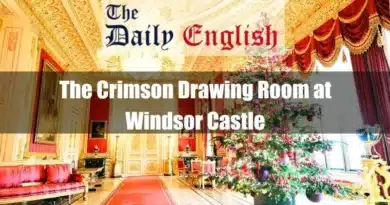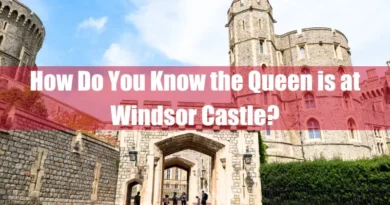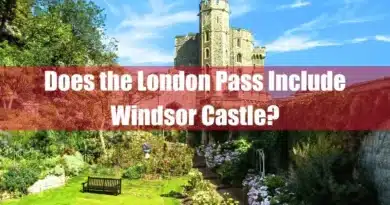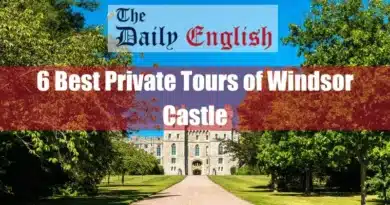I. Introduction
Windsor is a town situated on the River Thames, approximately 20 miles west of London. It’s known for its historic Windsor Castle, home to the British Royal Family. The Guildhall is located in the heart of Windsor town centre, on High Street, just 100 meters (330 ft) from Castle Hill, which leads to the main public entrance of Windsor Castle.
The Windsor Guildhall stands as a testament to the town’s rich history, evolving from a 12th-century market hall to a vibrant community centre and wedding venue today. Its architectural beauty, captivating interiors, and historical significance offer a unique glimpse into Windsor’s past while providing a versatile space for modern gatherings and celebrations. This article embarks on a journey through time, unveiling the Guildhall’s layers of stories and exploring its enduring legacy as a symbol of civic pride and cultural exchange.
II. Windsor Guildhall: A Journey Through Time
A. Echoes of a Market Town (12th – 14th Centuries)
- The Birth of a Trading Hub: Windsor’s bustling market town roots can be traced back to the 12th century, attracting merchants and traders from various regions. Historical evidence suggests that Guildhall’s origins lie in this period. While the exact date of construction for a wooden structure called the “Old Market House” around 1110 remains unclear, it likely served as the early foundation for the Guildhall. This simple building housed stalls overflowing with local produce, handcrafted goods, and exotic wares, functioning as the town’s economic heart.
- A Tapestry of Lives: Beyond mere commerce, the market was a vibrant social hub. Daily life unfolded amidst the cacophony of haggling, laughter, and bartering. Craftsmen displayed their wares, farmers sold their produce, and traders exchanged stories and news from distant lands. The market fostered a close-knit community, forging bonds between diverse social groups and enriching the lives of its inhabitants.
- Whispers of Royal Presence: Located just steps from Windsor Castle, the market held a special significance. It likely hosted royal visits and celebrations throughout the 12th and 13th centuries, witnessing key moments in English history. King Henry I, for instance, granted a charter to the town in 1121, further solidifying the market’s importance and establishing Windsor as a royal borough. These connections to the Crown underscore the market’s unique role in the town’s fabric.
Additional Notes:
- While the origins of the Guildhall date back to the 12th century, the current structure we see today was built between 1435 and 1461.
- The market flourished throughout the 14th century, vital to Windsor’s economic prosperity and social life.
The central pillars of Windsor Guildhall have sparked curiosity and debate for centuries. While some believe they were designed by the famed architect Sir Christopher Wren, historical documents suggest they existed before his involvement. Regardless of their origin, these pillars are a testament to the Guildhall’s enduring history and architectural intrigue. Though initially deemed unnecessary, their presence adds a touch of grandeur to the space and serves as a reminder of the building’s fascinating evolution.
- Who Lives in the Windsor Castle?
- Windsor Castle Opening Times: Everything You Need to Know.
- Windsor Castle Tickets: A Proven Comprehensive Guide.
- Windsor Great Park Stables: History and Today
B. The Rise of a Civic Icon (15th – 17th Centuries)

1. A Vision Realized:
By the 15th century, the market’s role began to shift. Recognizing its potential as a civic centre, King Henry VI commissioned renowned architect Sir Thomas Fiddes (also spelt Fitch or Fitz) to transform the Old Market House into a grand and imposing structure. Between 1435 and 1461. Fiddes meticulously crafted the Guildhall we see today, blending Perpendicular Gothic and Tudor styles to create an architectural masterpiece. The soaring timber roof, intricate stonework, and crenellated tower showcased the town’s growing prosperity and civic pride.
2. Witness to Power:
As the Guildhall rose, its importance as a centre of governance grew. The town’s council meetings were held within its walls, shaping Windsor’s policies and decisions. Monarchs visited the Guildhall, gracing it with their presence and solidifying its role as a symbol of civic authority. Notably, the wedding feast of Henry VIII and Jane Seymour took place in the Guildhall in 1536, further highlighting its prominence in Tudor England.
3. From Feasts to Trials:
Beyond governance, the Guildhall served a multitude of functions. It hosted lavish feasts and celebrations, witnessed legal proceedings and trials, and acted as a public gathering and announcement venue. This versatility ensured that the Guildhall remained a vibrant hub of activity, serving diverse needs and adapting to the time’s evolving social and political landscape.
Additional Notes:
- The 16th and 17th centuries saw further enhancements to the Guildhall, including adding the Council Chamber and the Assembly Room.
- By the late 17th century, the Guildhall had firmly established itself as the heart of Windsor’s civic and social life.
- Windsor Castle Changing of the Guard: Where History Coming Alive.
- Windsor Castle Tour: A Comprehensive and Best Guide.
C. A Stage for History (18th – 19th Centuries)
1. A Beacon of Enlightenment:
The 18th century witnessed a flourishing of civic centres across England. These centres often played a role in public discourse and intellectual pursuits. While the specific details of the Windsor Guildhall’s involvement in such activities remain unclear, its role as a central location for the town suggests it likely participated in this broader trend.
2. Revolution and Reform:
Amidst the tumultuous political landscape of the 18th and 19th centuries, the Guildhall remained a central stage for pivotal events. It witnessed the celebrations surrounding the American Revolution and the Napoleonic Wars, reflecting the town’s involvement in broader historical narratives. Additionally, the Guildhall served as a platform for political debates and reform movements, echoing the social and political changes sweeping across England.
3. From Georgian Elegance to Victorian Grandeur:
Architecturally, the Guildhall continued to evolve throughout this period. During the Georgian era, the focus shifted towards elegance and functionality. The Assembly Room was enlarged to accommodate grand social events, and the building’s exterior was adorned with Georgian architectural elements. By the Victorian era, the Guildhall embraced a more ornate and decorative style. Stained glass windows were added, and the interior was enriched with elaborate Victorian furnishings. These architectural transformations mirrored the evolving tastes and social trends of the times.
Additional Notes:
- The 19th century saw the Guildhall host notable figures, including Charles Dickens and Queen Victoria, further solidifying its status as a historical landmark.
- The Guildhall also significantly developed Windsor’s sanitation and infrastructure, reflecting the town’s growing attention to public health and civic improvements.
- By the late 19th century, the Guildhall had become a cherished symbol of Windsor’s rich history and vibrant community life.
- Windsor Castle Tickets Advantage Card: Know Everything.
- Also, know about The Best Bits of Windsor Castle
- The Windsor Castle Dogs
D. Adapting to the Modern Era (20th – 21st Centuries)

1. Preserving the Past:
Recognizing its historical significance, the 20th century saw the Guildhall evolve into a museum and heritage centre. 1951, the Guildhall Museum was officially established, showcasing artefacts, documents, and exhibits that unveiled the rich tapestry of Windsor’s past. This transformation ensured the preservation of the Guildhall’s historical fabric and provided a platform for educating future generations about their heritage.
2. A Platform for the Present:
The Guildhall always kept in touch with its contemporary relevance. Throughout the 20th and 21st centuries, it continued to serve as a vibrant venue for diverse events. From conferences and exhibitions to weddings and community gatherings, the Guildhall remained a dynamic space, adapting to the needs and interests of its modern audience.
3. Embracing the Future:
Looking forward, the Guildhall embraces the challenges and opportunities of the future. Sustainable practices are being implemented to reduce environmental impact, ensuring its longevity and commitment to responsible resource management. Additionally, the Guildhall actively participates in tourism initiatives, showcasing its historical treasures and contributing to Windsor’s economic growth and cultural identity.
Additional Notes:
- The Guildhall continues to undergo restoration and maintenance projects to preserve its architectural integrity and enhance its visitor experience.
- The Guildhall actively collaborates with local businesses and organizations, fostering partnerships that benefit the community and promote cultural exchange.
- As Windsor continues to evolve, the Guildhall remains a steadfast anchor, symbolizing the town’s rich heritage and its dynamic adaptation to the modern world.
- How Far is Windsor Castle from Buckingham Palace? Royal Mile?
- Devastating Timeline of the Windsor Castle Fire 1992.
E. Architectural Features and Evolution of Windsor Guildhall
1. Original Construction (15th Century):
- Perpendicular Gothic style: Characterized by pointed arches, large windows with stained glass, and elaborate stonework.
- Timber-framed roof: A striking and distinctive feature showcasing the carpentry skills of the period.
- Crenellated tower: Added a defensive element and emphasized the building’s civic importance.
2. Subsequent Additions and Modifications (16th-19th Centuries):
- Council Chamber: Built in the 16th century, featuring Jacobean-style panelling and decorative ceilings.
- Assembly Room: Expanded in the 18th century to accommodate grand social events, with Georgian elements like sash windows and decorative plasterwork.
- Victorian Stained Glass: Added in the 19th century, enriching the interior with vibrant colours and intricate designs.
3. Overall Evolution:
The Guildhall retains its core Perpendicular Gothic character, but subsequent additions demonstrate a blending of styles reflecting the architectural trends of different periods. The building’s evolution reflects its changing role, from a market hall to a civic centre and now a cultural and event space.
4. Specific Architectural Elements:
- Flying buttresses: Provide structural support and add a touch of Gothic flair.
- Large open hall: This creates a sense of spaciousness and allows for flexibility in use.
- Ornate fireplaces: Add warmth and charm to the interior.
- Decorative carvings and mouldings: Showcase the craftsmanship of past generations.
These elements and the evolving architectural styles contribute to the Windsor Guildhall’s unique character and historical significance.
- State Apartments at Windsor Castle: An Ultimate Guide.
- St. George’s Chapel at Windsor Castle in History & Today.
F. Social Impact on the Local Economy
Throughout its history, the Guildhall has significantly impacted Windsor’s economic prosperity. In its early days as a market hall, it attracted traders and merchants, fueling commerce and generating local employment. As it evolved into a civic centre, the Guildhall hosted events like feasts and weddings, boosting the hospitality and service sectors. Additionally, its function as a legal venue attracted lawyers, judges, and clerks, further diversifying the local economy.
By providing a platform for cultural exchange and artistic expression, the Guildhall contributed to the town’s attractiveness, drawing visitors and fueling tourism, which continues to be a major economic driver for Windsor today. Overall, the Guildhall has played a crucial role in shaping residents’ livelihoods by creating jobs, fostering trade, and contributing to the town’s overall economic health.
G. In-depth Exploration of Historical Events
1. 1121: Granting of the Charter by King Henry I
King Henry I bestowed a royal charter upon Windsor in 1121, solidifying its status as a borough and granting it certain liberties and privileges. This event significantly impacted Windsor’s development and solidified the town’s connection to the Crown. The Guildhall, which emerged from the earlier Old Market House, played a central role in civic governance from its early days. The charter’s influence likely contributed to the Guildhall’s growing importance as a center of local administration.
- Queen Mary’s Dollhouse at Windsor Castle.
- Windsor Great Park: A Legacy of History, Nature, and Royal Heritage.
2. The English Civil War (1642-1651)
The turbulent period of the English Civil War undoubtedly impacted Windsor Guildhall. While the specific details of its use during the conflict remain unclear, the Guildhall’s central location and civic importance suggest it likely played a role in the events of the war.
These events significantly impacted the Guildhall’s historical significance by:
- Highlighting its connection to royal authority: The 1121 charter established a link between the Guildhall and the Crown, solidifying its position as a centre of local governance.
- Demonstrating its adaptability: Throughout history, the Guildhall has served diverse functions, adapting to the town’s evolving needs.
- Emphasizing its importance as a civic centre: The Guildhall’s central location and historical significance continue to make it a focal point for Windsor’s community life.
These events collectively contributed to the Guildhall’s rich history, solidifying its position as a landmark witness to Windsor’s evolution.
III. The Guildhall Today
A. Exploring Windsor Guildhall as a Premier Wedding Venue
The Windsor Guildhall has transcended its historical significance to become a highly sought-after venue for modern weddings. Its breathtaking architecture, adaptable spaces, and exceptional services create a unique and unforgettable backdrop for couples to celebrate their love.
1. Enchanting Spaces and Diverse Options:
- Intimate Gatherings: The Council Chamber offers a charming setting in natural light, perfect for smaller ceremonies and receptions. To ensure a comfortable experience, the Council Chamber can accommodate up to 30 guests for seated ceremonies and receptions.
- Grand Celebrations: With its soaring timber roof, the Assembly Room transforms into a magnificent ballroom for larger weddings. The Assembly Room boasts a capacity of up to 100 guests for seated ceremonies and receptions.
- Outdoor Elegance: The picturesque Guildhall gardens provide a tranquil space for wedding ceremonies and photographs, subject to noise ordinances enforced after a certain time.
- Windsor and Royal Borough Museum (WRBM)
- Eton College Windsor: A Legacy of Excellence
- Frogmore House Windsor: A Royal Retreat Through Centuries
2. Personalized Experiences and Exquisite Services:
- Dedicated Wedding Coordinator: A dedicated team collaborates with couples to tailor every detail of their wedding, ensuring a seamlessly executed and personalized experience.
- Exquisite Catering: Skilled chefs create bespoke menus focusing on fresh, seasonal ingredients and impeccable presentation. Dietary restrictions and preferences can also be accommodated.
- Elegant Ambiance: The Guildhall’s professional staff ensures a flawlessly decorated and meticulously organized setting, reflecting the couple’s vision. Floral arrangements, furniture layout, and audio-visual equipment can all be customized.
3. A Storybook Setting:
- Historical Charm: Couples can exchange vows amidst the grandeur of the Guildhall, surrounded by centuries of history and architectural beauty. The venue’s rich heritage creates a truly unique atmosphere.
- Iconic Location: Situated in the heart of Windsor, the Guildhall offers convenient access to Windsor Castle and the River Thames, allowing couples to incorporate these landmarks into their wedding story. The close proximity to these iconic locations adds a touch of regality to the wedding experience.
- Unforgettable Memories: The Guildhall’s unique atmosphere and personalized services create lasting memories for couples and their guests. From the beautiful surroundings to the exceptional service, the Guildhall strives to make every wedding special.
IV. The Guildhall and Beyond
A. Fostering Artistic Expression and Community Engagement
The Guildhall extends its mission beyond weddings and events, serving as a vibrant hub for cultural exchange and community engagement.
1. Diverse Cultural Programs
- Exhibitions: The Guildhall Museum features temporary exhibitions exploring various themes and historical periods, offering educational and engaging experiences for visitors.
- Performances: The Guildhall hosts a diverse range of performances, from concerts and theatrical productions to poetry readings and dance recitals, enriching the cultural landscape of Windsor.
- Lectures and Workshops: The Guildhall organizes lectures and workshops on various topics, such as local history, art, and current affairs, fostering intellectual curiosity and community dialogue.
2. Dialogue and Collaboration through the Guildhall
- Community Events: The Guildhall hosts various community events, such as festivals, fairs, and celebrations, fostering social interaction and cultural exchange.
- Meeting Spaces: The Guildhall provides affordable and accessible meeting spaces for non-profit organizations and community groups, facilitating dialogue and collaboration.
- Public Forums: The Guildhall holds public forums and discussions on relevant issues, promoting civic engagement and participatory democracy.
- The Long Walk, Windsor Castle Through Time
- The Windsor Castle Fire 1992: A Historical Catastrophe.
B. The Guildhall’s Enduring Impact on Windsor’s Identity
The Windsor Guildhall stands as a testament to the town’s resilience and evolution, continuously adapting to the changing tides of history while retaining its core values of civic responsibility and cultural enrichment.
1. Shaping the Town’s Narrative
- Preserving History: The Guildhall acts as a repository of Windsor’s rich history, ensuring its preservation for future generations through its museum and archives.
- Inspiring Future Leaders: The Guildhall nurtures the next generation of civic-minded individuals by providing educational programs and community engagement opportunities.
- Adapting to Change: Throughout its history, the Guildhall has demonstrated its ability to adapt to changing times, ensuring its continued relevance in the modern world.
2. A Symbol of Unity
- Community Hub: The Guildhall serves as a central gathering place for residents, fostering social cohesion and a sense of belonging.
- Civic Pride: The Guildhall’s architectural grandeur and historical significance instil community pride and a shared sense of identity among residents.
- Celebrating Diversity: The Guildhall’s diverse programming and commitment to inclusivity promotes understanding and respect between different cultural groups.
3. A Window to the World
- Tourist Destination: The Guildhall attracts visitors from across the globe, showcasing Windsor’s history and culture to a wider audience.
- International Partnerships: The Guildhall welcomes international artists and cultural organizations, fostering collaboration and exchanging ideas.
- A Beacon of Hospitality: The Guildhall’s staff and volunteers warmly welcome visitors, creating a positive and inclusive environment for all.
- The Windsor Castle Fire Salvage Operation 1992.
- The Extent of Damage to Windsor Castle Due to the 1992 Fire.
- Restoration of Windsor Castle after the Devastating Fire in 1992.
V. Citations
- Hakewill, J. (1813, January 1). The History of 11Windsor, and Its Neighbourhood. http://books.google.ie/books?id=mlhjyubNh_sC&printsec=frontcover&dq=The+History+of+Windsor&hl=&cd=1&source=gbs_api
- Brindle, S. (1997, January 1). Windsor Revealed. http://books.google.ie/books?id=EOdYswEACAAJ&dq=The+History+of+Windsor&hl=&cd=3&source=gbs_api
- Jesse, E. (2016, August 27). WINDSOR CASTLE & ITS ENVIRONS. http://books.google.ie/books?id=OaVIvgAACAAJ&dq=Windsor+Castle+and+Its+Environs&hl=&cd=3&source=gbs_api
- Marson, P., Mitchell, B., & Friends, W. R. B. M. (2011, January 1). Windsor Guildhall. Hodder Christian Books. http://books.google.ie/books?id=EMetkQEACAAJ&dq=Windsor+Guildhall&hl=&cd=2&source=gbs_api
- Welch, C. (1901, January 1). A Brief Guide to the Guildhall Museum . . . http://books.google.ie/books?id=snkwGwAACAAJ&dq=The+Guildhall+Museum&hl=&cd=1&source=gbs_api










Comments are closed.